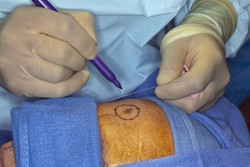Advancing skin imaging
Melanoma is the most aggressive type of skin cancer and highly prevalent among young women up to the age of 29. The overall incidence of skin cancer in US alone has risen by nearly 700 % from 1950 to 2001, clearly demonstrating the health threat posed by sun exposure. These dismal statistics will only worsen considering the UV hazard resulting from ozone depletion, as well as an increasing aging population. The five year survival rate for people with skin cancer is higher than 95 % if detected and treated early. However, most medical doctors are still using visual inspection as the only diagnostic method for skin cancer. The scope of the EU-funded SKINSPECTION (Multimodal skin inspection with hybrid acoustic & optical spectroscopic imaging) project was to advance inspection of skin lesions both on the macroscopic and the microscopic level. Existing inspection modalities are more descriptive than quantitative, lacking certain information, resolution, and clinical applicability. SKINSPECTION scientists set out to address these limitations through a multimodal imaging approach combining multiphoton tomography, fluorescence lifetime imaging, optoacoustic imaging (OA) and high resolution ultrasound. This offers a non-invasive method of viewing dermatological lesions with molecular analysis, subcellular resolution of the upper skin layers and temporal resolution. OA generates broadband ultrasound signals by absorption of short laser pulses allowing the capture of images down to 3 mm in depth and sub-100µm resolution. Following extensive development and certification for clinical testing, the evaluation of the platform was performed in a clinical study. Over 700 lesions were imaged and a statistical analysis of the data indicated a correlation among defined cell features and disease. Apart from excellent sensitive differentiation between lesion types, the system proved highly suitable for high resolution non-invasive imaging of subcutaneous vasculature. Taken together, the SKINSPECTION imaging platform comprises a unique tool for the detection and diagnosis of skin cancer. Apart from cancer, partners envision a wider applicability for the detection of non-neoplastic skin disorders and reconstructive surgery.
Keywords
Skin cancer, melanoma, diagnostic, multiphoton tomography, fluorescence lifetime imaging, optoacoustic imaging, ultrasound







